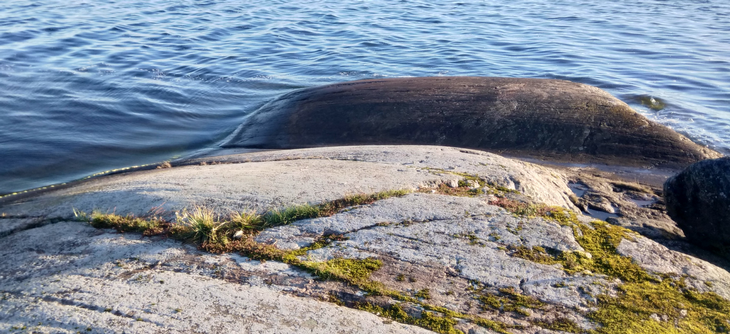Sheepbacks - glacial landforms
During the last ice age (approx. 115,000 - 10,000 years before today), all of Scandinavia was covered by thick ice sheets. The movement of these ice masses removed all layers of soil as well as organic material, so that today in many places the bare bedrock is revealed. In Sörmland this is mostly granite and gneiss, partly also limestone.
The movement of the ice was directed southwards and formed granite and gneiss blocks into rounded humps, called sheepbacks or roches moutonées, which can be seen frequently in Scandinavia’s landscape. Partly these glacial forms are now covered by vegetation, partly they lie bare both on land and as islands and islets in the Baltic Sea.
First, let's take a closer look at their shape. Sheepbacks have an asymmetric structure with a gently sloping flank, the stoss face (towards the north) and a steeply sloping lee side (towards the south). Their size ranges from a few meters to kilometers. Such particularly large sheepbacks, however, occur less frequently.

Fig.1: Sheepback at the coast of Sörmland (2021).
But how exactly did these sheepbacks come into existence?
One characteristic of active glaciers is their movement. In Scandinavia, this movement was more or less north-south directed, i.e. from the accumulation zone to the ablation zone. When the glacier ice met a rock obstacle, it had to flow around it. In this process, pressure initially built up on the impact side, which led to partial melting of the ice on the underside of the glacier. The stoss side, roughly oriented to the north, was thus abraded and today represents the gently sloping side of the round hump. In geology, this process is called detersion or abrasion.
On the other side of the rock obstacle, the pressure dropped insantaneously and the underside of the glacier froze to the rock. The forces of the glacier were greater than the cohesion of the rock, and the continuing movement tore more or less large stones and rocks out of the lee side. This process is called detraction and the resulting steeply sloping flank of the round hump can also consist of steps, depending on the size of the overall shape.

Fig.2: Formation of sheepbacks by detersion and detraction; (adapted after: Jasmin Ros; CC BY-SA 3.0).
The surfaces of these glacial forms are usually covered with rills and glacial grooves, which were created by pressure and movement of the glaciers and the debris frozen underneath.
In Sörmland, as well as the rest of Scandinavia, sheepbacks occur numerously in the landscape. Keep your eyes open next time and I'm sure you'll find some examples. I like to take up the topic of the Ice Age in my guided hikes, where we look at different glacial and glaciofluvial forms together.
More information about the day trip „Time Travel to the Ice Age“.
Post sources:
- Géologie Québec: https://gq.mines.gouv.qc.ca/lexique-stratigraphique/quaternaire/roche-moutonnee/
- Rundhöcker Wikipedia: https://de.wikipedia.org/wiki/Rundh%C3%B6cker
There are no reviews yet.